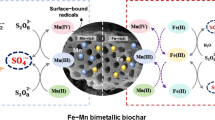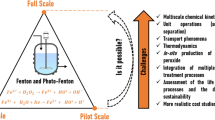Abstract
The main disadvantage of using iron mineral in Fenton-like reactions is that the decomposition rate of organic contaminants is slower than in classic Fenton reaction using ferrous ions at acidic pH. In order to overcome these drawbacks of the Fenton process, chelating agents have been used in the investigation of Fenton heterogeneous reaction with some Fe-bearing minerals. In this work, the effect of new iron complexing agent, ethylenediamine-N,N'-disuccinic acid (EDDS), on heterogeneous Fenton and photo-Fenton system using goethite as an iron source was tested at circumneutral pH. Batch experiments including adsorption of EDDS and bisphenol A (BPA) on goethite, H2O2 decomposition, dissolved iron measurement, and BPA degradation were conducted. The effects of pH, H2O2 concentration, EDDS concentration, and goethite dose were studied, and the production of hydroxyl radical (•OH) was detected. The addition of EDDS inhibited the heterogeneous Fenton degradation of BPA but also the formation of •OH. The presence of EDDS decreases the reactivity of goethite toward H2O2 because EDDS adsorbs strongly onto the goethite surface and alters catalytic sites. However, the addition of EDDS can improve the heterogeneous photo-Fenton degradation of BPA through the propagation into homogeneous reaction and formation of photochemically efficient Fe-EDDS complex. The overall effect of EDDS is dependent on the H2O2 and EDDS concentrations and pH value. The high performance observed at pH 6.2 could be explained by the ability of O •−2 to generate Fe(II) species from Fe(III) reduction. Low concentrations of H2O2 (0.1 mM) and EDDS (0.1 mM) were required as optimal conditions for complete BPA removal. These findings regarding the capability of EDDS/goethite system to promote heterogeneous photo-Fenton oxidation have important practical implications for water treatment technologies.







Similar content being viewed by others
References
Brotons JA, Olea-Serrano MF, Villalobos M, Pedraza V, Olea N (1995) Xenoestrogens released from lacquer coatings in food cans. Environ Health Perspect 103:608–612
Charbouillot T, Brigante M, Mailhot G, Maddigapu PR, Minero C, Vione D (2011) Performance and selectivity of the terephthalic acid probe for •OH as a function of temperature, pH and composition of atmospherically relevant aqueous media. J Photochem Photobiol A 222:70–76
Dulin D, Mill T (1982) Development and evaluation of sunlight actinometers. Environ Sci Technol 16:815–820
Gultekin I, Ince NH (2007) Synthetic endocrine disruptors in the environment and water remediation by advanced oxidation processes. J Environ Manage 85:816–832
Hanna K (2012) Comment on “Inhibitory effect of dissolved silica on H2O2 decomposition by iron(III) and manganese(IV) oxides: implications for H2O2–based in situ chemical oxidation”. Environ Sci Technol 46:3591–3592
Hanna K, Carteret C (2007) Sorption of 1-hydroxy-2-naphthoic acid to goethite, lepidocrocite and ferrihydrite: batch experiments and infrared study. Chemosphere 70:178–186
Hanna K, Kone T, Medjahdi G (2008) Synthesis of the mixed oxides of iron and quartz and their catalytic activities for the Fenton-like oxidation. Catal Commun 9:955–959
Huang W, Brigante M, Wu F, Hanna K, Mailhot G (2012a) Development of a new homogenous photo-Fenton process using Fe(III)-EDDS complexes. J Photochem Photobiol A: Chem 239:17–23
Huang W., Brigante M., Wu F., Hanna K., Mousty C., Mailhot G. (2012b) Assessment of the Fe(III)-EDDS complex in Fenton-like processes: from the radical formation to the degradation of Bisphenol A. Environ Sci Technol (under revision).
Ioan I, Wilson S, Lundanes E, Neculai A (2007) Comparison of Fenton and sono-Fenton bisphenol A degradation. J Hazard Mater 142:559–563
Kwan WP, Ph.D. (2003) Mechanisms of Fenton-like reactions on iron oxide surfaces. Thesis, Massachusetts Institute of Technology, Cambridge, MA, USA, and references cited therein.
Li J (2010) 17b-estradiol degradation photoinduced by iron complex, clay and iron oxide minerals: effect of the iron complexing agent ethylenediamine-N-N′-disuccinic acid. University Blaise Pascal, France
Li FB, Li XZ, Li XM, Liu TX, Dong J (2007) Heterogeneous photodegradation of bisphenol A with iron oxides and oxalate in aqueous solution. J Colloid Interface Sci 311:481–490
Li J, Mailhot G, Wu F, Deng N (2010) Photochemical efficiency of Fe (III)-EDDS complex: OH radical production and 17β-estradiol degradation. J Photochem Photobiol A212:1–7
Lin SS, Gurol MD (1998) Catalytic decomposition of hydrogen peroxide on iron oxide: kinetics, mechanism, and implications. Environ Sci Technol 32:1417–1423
Matta R, Hanna K, Chiron S (2007) Fenton-like oxidation of 2, 4, 6-trinitrotoluene using different iron minerals. Sci Total Environ 385:242–251
Mazellier P, Bolte M (2000) Heterogeneous light-induced transformation of 2,6-dimethylphenol in aqueous suspensions containing goethite. J Photochem Photobiol A, 132:129–135
Miller CM, Valentine RL (1999) Mechanistic studies of surface catalyzed H2O2 decomposition and contaminant degradation in the presence of sand. Water Res 33:2805–2816
Millington KR, Kirschenbaum LJ (2002) Detection of hydroxyl radicals in photoirradiated wool, cotton, nylon and polyester fabrics using a fluorescent probe. Color Technol 118:6–14
Ohko Y, Ando I, Niwa C, Tatsuma T, Yamamura T, Nakashima T, Kubota Y, Fujishima A (2001) Degradation of bisphenol A in water by TiO2 photocatalyst. Environ Sci Technol 35:2365–2368
Orama M, Hyvonen H, Saarinen H, Aksela R (2002) Complexation of [S,S] and mixed stereoisomers of N,N′-ethylenediaminedisuccinic acid (EDDS) with Fe(III), Cu(II), Zn(II) and Mn(II) ions in aqueous solution. J Chem Soc, Dalton Trans 24:4644–4648
Parks GA, de Bruyn PL (1962) The zero point of charge of oxides. J Phys Chem 66:967–973
Prélot B et al (2003) Morphology and surface heterogeneities in synthetic goethites. Colloid Interf Sci 261:244–254
Schwertmann U, Cornell RM (2000) Iron oxides in the laboratory: preparation and characterization. Wiley, New York
Suarez S, Sueiro RA, Garrido J (2000) Genotoxicity of the coating lacquer on food cans, bisphenol A diglycidyl ether (BADGE), its hydrolysis products and a chlorohydrin of BADGE. Mutat Res 470:221–228
Torres RA, Sarantakos G, Combet E, Petrier C, Pulgarin C (2008) Sequential helio-photo-Fenton and sonication processes for the treatment of bisphenol A. J Photochem Photobiol A 199:197–203
Usman M, Faure P, Ruby C, Hanna K (2012) Remediation of PAH-contaminated soils by magnetite catalyzed Fenton-like oxidation. Appl Catal B: Environ 117:10–17
Valentine RL, Ann Wang HC (1998) Iron oxide surface catalyzed oxidation of quinoline by hydrogen peroxide. J Environ Eng 124:31–39
Xue X, Hanna K, Abdelmoula M, Deng N (2009a) Adsorption and oxidation of PCP on the surface of magnetite: kinetic experiments and spectroscopic investigations. Appl Catal B-Environ 89:432–440, and references cited therein
Xue X, Hanna K, Despas C, Wu F, Deng N (2009b) Effect of chelating agent on the oxidation rate of PCP in the magnetite/H2O2 system at neutral pH. J Mol Catal A-Chem 311:29–35
Yamamoto T, Yasuhara A, Shiraishi H, Nakasugi O (2001) Bisphenol A in hazardous waste landfill leachates. Chemosphere 42:415–418
Zhao Y, Hu J, Chen H (2010) Elimination of estrogen and its estrogenicity by heterogeneous photo-Fenton catalyst β-FeOOH/resin. J. Photochem Photobiol A 212:94–100
Acknowledgements
The authors gratefully acknowledge the Ministry of Education of the PR of China for providing financial support for Dr. Wenyu Huang to stay at the Blaise Pascal University in Clermont-Ferrand, France. This work was supported by the “Federation des Recherches en Environnement” through the CPER “Environnement” founded by the “Région Auvergne,” the French Government, and FEDER from European community. This work was also supported by Natural Science Foundation of China (No. 21077080) and the Specialized Research Fund for the Doctoral Program of Higher Education of China (No. 20100141110046).
Author information
Authors and Affiliations
Corresponding author
Additional information
Responsible editor: Philippe Garrigues
Electronic Supplementary Materials
Below is the link to the electronic supplementary material.
ESM 1
(DOC 1359 kb)
Rights and permissions
About this article
Cite this article
Huang, W., Brigante, M., Wu, F. et al. Effect of ethylenediamine-N,N′-disuccinic acid on Fenton and photo-Fenton processes using goethite as an iron source: optimization of parameters for bisphenol A degradation. Environ Sci Pollut Res 20, 39–50 (2013). https://doi.org/10.1007/s11356-012-1042-6
Received:
Accepted:
Published:
Issue Date:
DOI: https://doi.org/10.1007/s11356-012-1042-6




